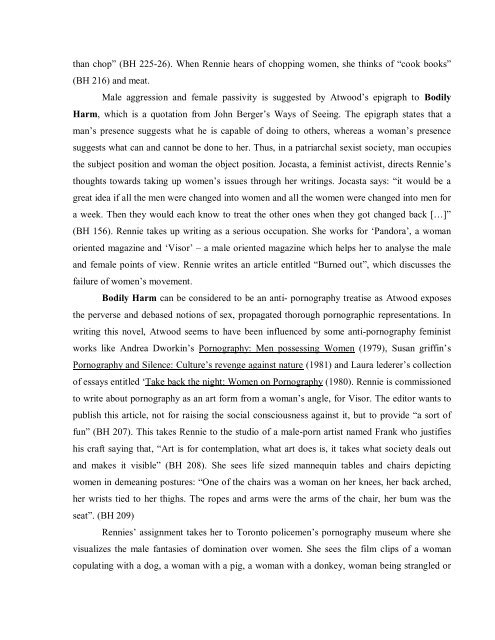A Multidisciplinary Research Journal - Devanga Arts College
A Multidisciplinary Research Journal - Devanga Arts College
A Multidisciplinary Research Journal - Devanga Arts College
Create successful ePaper yourself
Turn your PDF publications into a flip-book with our unique Google optimized e-Paper software.
than chop” (BH 225-26). When Rennie hears of chopping women, she thinks of “cook books”<br />
(BH 216) and meat.<br />
Male aggression and female passivity is suggested by Atwood’s epigraph to Bodily<br />
Harm, which is a quotation from John Berger’s Ways of Seeing. The epigraph states that a<br />
man’s presence suggests what he is capable of doing to others, whereas a woman’s presence<br />
suggests what can and cannot be done to her. Thus, in a patriarchal sexist society, man occupies<br />
the subject position and woman the object position. Jocasta, a feminist activist, directs Rennie’s<br />
thoughts towards taking up women’s issues through her writings. Jocasta says: “it would be a<br />
great idea if all the men were changed into women and all the women were changed into men for<br />
a week. Then they would each know to treat the other ones when they got changed back […]”<br />
(BH 156). Rennie takes up writing as a serious occupation. She works for ‘Pandora’, a woman<br />
oriented magazine and ‘Visor’ – a male oriented magazine which helps her to analyse the male<br />
and female points of view. Rennie writes an article entitled “Burned out”, which discusses the<br />
failure of women’s movement.<br />
Bodily Harm can be considered to be an anti- pornography treatise as Atwood exposes<br />
the perverse and debased notions of sex, propagated thorough pornographic representations. In<br />
writing this novel, Atwood seems to have been influenced by some anti-pornography feminist<br />
works like Andrea Dworkin’s Pornography: Men possessing Women (1979), Susan griffin’s<br />
Pornography and Silence: Culture’s revenge against nature (1981) and Laura lederer’s collection<br />
of essays entitled ‘Take back the night: Women on Pornography (1980). Rennie is commissioned<br />
to write about pornography as an art form from a woman’s angle, for Visor. The editor wants to<br />
publish this article, not for raising the social consciousness against it, but to provide “a sort of<br />
fun” (BH 207). This takes Rennie to the studio of a male-porn artist named Frank who justifies<br />
his craft saying that, “Art is for contemplation, what art does is, it takes what society deals out<br />
and makes it visible” (BH 208). She sees life sized mannequin tables and chairs depicting<br />
women in demeaning postures: “One of the chairs was a woman on her knees, her back arched,<br />
her wrists tied to her thighs. The ropes and arms were the arms of the chair, her bum was the<br />
seat”. (BH 209)<br />
Rennies’ assignment takes her to Toronto policemen’s pornography museum where she<br />
visualizes the male fantasies of domination over women. She sees the film clips of a woman<br />
copulating with a dog, a woman with a pig, a woman with a donkey, woman being strangled or



